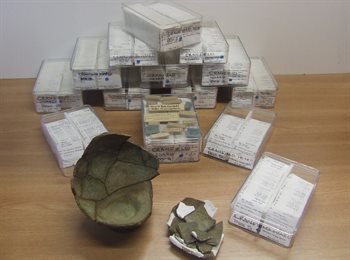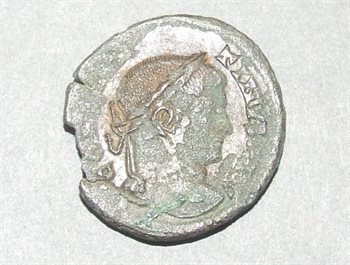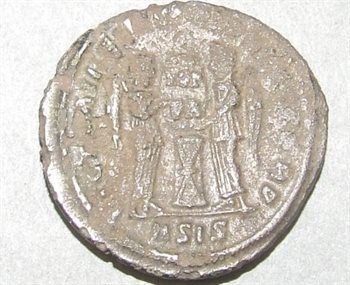Cranfield in the Romano-British Era
This page was written by Sally Williams, Derry Young, Paul and Dawn Jeffery
There was clearly plenty of activity during the Roman period in the parish. Evidence suggests that there were Romans living in Cranfield and also passing through. There is no evidence yet of a Roman road or track passing through the village but given the location of Roman finds it seems likely that they were using the high ground and plateau to travel East – West, possibly linking the Watling Street, today’s (A5) with the Great North Road (A1).
The Home Farm archaeological explorations have identified Roman roundhouses that were rebuilt over time suggesting ongoing occupation. Artefacts of roof tile and brick together with pottery sherds have come to light. [HER 13418]
Of particular interest are a copper alloy toilet spoon probably used for make up or manicure purposes, a gaming piece and fragments of Samian Ware, which is a high-quality pottery imported from Gaul between the 1st and 3rd centuries. Also fragments of a brooch and a bracelet have been found.
Taking all this together, it suggests that a higher than normal status person(s) lived in Cranfield.
Other finds have included a hobnail which may have come from a military boot, a metal ring, and iron latch lifter, and a T clamp. Other finds relating to everyday life have included fragments of a beaker, jar and mortarium. [HER13418]
Oyster shells and animal bones of ox/cow, sheep, goat and dog tell us more about the diet and way of life.
Some interesting trenches in rows have been identified and called bedding trenches. These have straight sides, are 80 cm wide and 40 cm deep. Archaeologists are speculating whether this was a vineyard.
Roman pottery has also been found at Wharley Ringtail Farm. [HER 47]
There have been two very significant fines of quantities of Roman coins within the parish. The best-known is the Wharley Farm Hoard which was discovered in 1946.
The Wharley Farm Roman Coin Hoard
In 1946, a farmworker ploughing in Wharley End struck an earthen ware jar. He found it contained a mass of small coins: what is now known as the Cranfield Hoard consisting of 1,700 Roman coins of small denominations. [HER 46]

The 14 boxes containing the Roman coins post conservation and identification along with the pot in which they were found. Images courtesy of the Higgins Art gallery and Museum Bedford
The hoard has been in the care of the Higgins Art Gallery and Museum Bedford since 1967 where it has been carefully conserved and recorded.
Most of the coins date from the later period of Roman occupation: the earliest coin is after A.D. 317 and the majority of the hoard was struck before A.D. 335. The origin of the coins is almost exclusively from the Western part of the Roman Empire. Only the coins from Licinius I and II were minted in the Eastern Empire. Below is listed the emperors and their empresses depicted on the obverse of the coins. Apart from 34 of the smaller later coins, all of the hoard are of one denomination: the characteristic 3 AE of Constantine which continued unchanged except for its slight reduction in weight during its whole course.

A follis from Constantine I (mint of Lugdunum). Images courtesy of the Higgins Art gallery and Museum Bedford
This example dates from AD 323/4 and is a coin called a follis, minted in Lyons (Lugdunum) France in a non-precious metal. The front shows Constantine I wearing a laurel wreath and the reverse shows Victory holding a trophy in her right hand and a palm frond in her left, with a captive at her feet. This coin commemorates Constantine’s victory in the Sarmation War of 322.

Follis from Constantine I (mint of Siscia). Images courtesy of the Higgins Art gallery and Museum Bedford
This is a follis from the time of Constantine The Great wearing a laurel wreath and a helmet, minted in Siscia, (Sisak in modern day Croatia). The reverse shows two Victories standing holding a shield inscribed VOT PR above an altar. VOT P R on the shield abbreviates, Vota Populi Romani, which translates, "Vows (prayers) of the Roman people."
The lettering around the circumference says VICTORIAE LAETAE PRINC PERP (joyous eternal victories of the prince).

Follis of Constantine I AD 332. Images courtesy of the Higgins Art gallery and Museum Bedford
This follis shows Constantine I in helmet and armour facing to the left. The reverse has the winged Victory and commemorates the foundation of Constantinopolis (later Byzantium, now Istanbul). It was minted in Lyons, France.
Of particular interest is the quite large number of coins which appeared to have been deliberately defaced, apparently with some broad blunt instrument. It is possible that this defacement was deliberately intended to de-monitise the coins to take them out of circulation. The most likely timescale would be in A.D. 348 when new coins were issued to supersede the mass of coins already in existence. There are a couple of government edicts surviving from this period which show us that existing coins could be de-monitised and called in.
Emperors and Empresses depicted on the obverse of coins
There are 471 coins showing Constantine I, also known as Constantine The Great 307 – 337 AD. He was the first Roman Emperor to convert to Christianity. Constantine II, his son, is on 389 of the coins.
Around 300 of the coins are known as City Commemoratives and were minted under Constantine I and his sons. These coins celebrate the founding of Constantinopolis (Constantinople) and also Urbs Roma, the city of Rome.
The reverse of the Constantinopolis coins shows the winged Victory standing on the prow of a ship and the reverse of the Urbs Roma shows a female wolf suckling the infants Romulus and Remus.
List of emperors and empresses depicted on the coins
|
Emperor/empress
|
Number in the hoard
|
Emperor/empress
|
Number in the hoard
|
|
Claudius II AD 268-270
|
1
|
Crispus A.D 317-326 (eldest son of Constantine I and murdered by him after Fausta accused him of rape)
|
226
|
|
Tetriculus I AD 270-273 (Gallic Empire)
|
2
|
Constantine II A.D. 337-340 (died in battle against Constans)
|
389
|
|
Constantine I AD 307-337
|
471
|
Constans AD 337-350 (brother of Constantine II
|
3
|
|
Licinius I AD 308-324 (Eastern Empire)
|
3
|
Constantius II AD 337-361 (brother of Constantine II and Constans and outlived them to become to sole heir)
|
74
|
|
Licinius II AD 317-324 (Eastern Empire and ended up in slavery)
|
5
|
City Commemorative
Constantinopolis
|
150
|
|
Helena d AD 329 (mother of Constantine I)
|
30
|
City Commemorative
Urbs Roma
|
151
|
|
Fausta A.D.326 – (first wife of Constantine I)
|
4
|
Uncertain
|
187
|
|
Theodora AD 337-340 (second wife of Constantine I)
|
4
|
Total
|
1700
|
The Wharley Farm, Cranfield Hoard has coins minted across the Roman world for example, Sisak in Croatia, Trier in Germany, Pavia Italy, Lyons and Arles France and Constantinople as well as London. All the mints that have been identified are listed below.
Mints of coinage
|
Mint
|
Number in the hoard
|
Mint
|
Number in the hoard
|
|
Aquileia (Aquileia, Italy)
|
3
|
Lugdunum (Lyons, France)
|
121
|
|
Arelatum (Arles, France)
|
45
|
Rome (Italy)
|
5
|
|
Constantinople (Istanbul, Turkey)
|
2
|
Siscia (Sisak, Croatia)
|
16
|
|
Cyzicus (Kapu Dhag, Turkey)
|
1
|
Thessalonika (Saloniki, Greece)
|
3
|
|
Heraclea (Bitola, Macedonia)
|
1
|
Ticinum (Pavia, Italy)
|
12
|
|
Londinium (London, UK)
|
249
|
Treveri (Trier, Germany)
|
517
|
|
|
|
Uncertain or not marked
|
725
|
A second hoard was found during works at the parish church of Saintt Peter and Saint Paul. A reference to a visit by the Bedfordshire Archaeological Society to Cranfield in 1854 includes a mention of Roman, medieval and post-medieval coins found within the parish being shown to the Society members. The Victoria County History states that the Roman coins were found in the churchyard during restoration of the church. The number, quantity and current location of the coins is unknown.
We can only speculate on who buried these coins and why. Presumably they were placed in the ground to protect them and their owner from a perceived risk.